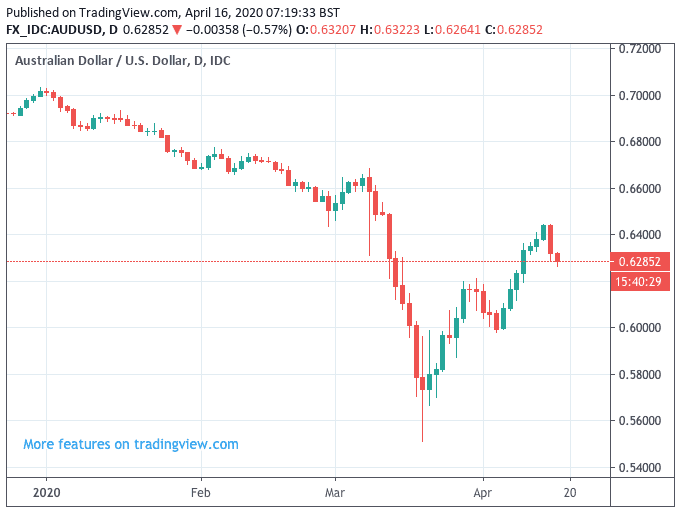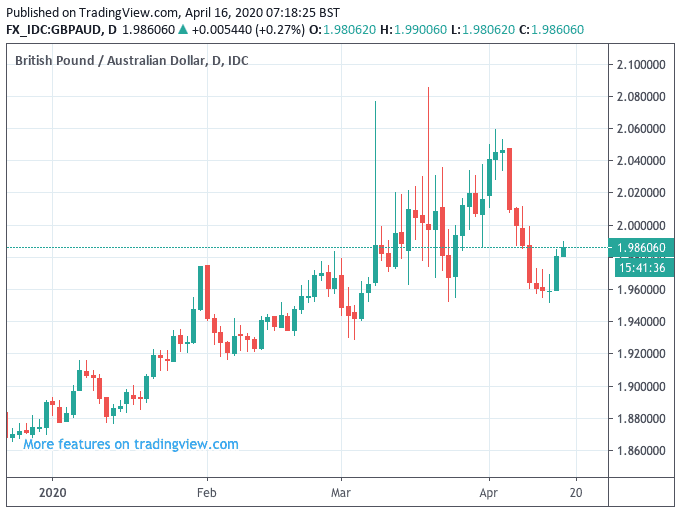Firm Australian Dollar Jobs Data has Fleeting Positive Impact as Recovery Stalls on Global Investor Anxieties
- Aussie Dollar softer on Thursday
- Aus jobs data beats expectations
- But overall market sentiment trumps jobs numbers for AUD
- Latest coronacrisis GBP/AUD forecasts available for download at Global Reach

- GBP/AUD market rate at time of writing: 1.9824
- Bank transfer rates (indicative): 1.9130-1.9270
- FX specialist rates (indicative): 1.9340-1.9646 >> more information
The Australian Dollar lost further purchasing power on global FX markets on Thursday amidst an environment of subdued market sentiment, with a further half a percent loss being recorded against the U.S. Dollar leading investors to question the sustainability of the Aussie Dollar's recent recovery.
Losses for the Australian Dollar were also recorded against the Pound and Euro, with foreign exchange markets apparently unwilling to take any positives away from Australia's March employment report that came in much better than economists had expected.
March employment rose 5.9K versus a consensus estimate for -30K,
The unemployment rate rose by 0.1% to 5.2%. Underemployment also rose by 0.1% to an almost three-year high of 8.8%, while underutilisation of labour hit 14% for the first time in almost two years. The participation was steady at 66.0%.
Despite the better-than-expected headline figures, it appears markets are discounting the data as the survey period fell in first two weeks of March and therefore prior to the period of stricter social distancing introduced by the government.
The ABS reported “some small early impact” from COVID-19 but noted that “any impact from the major COVID-19 related actions will be evident in the April data”.
"There will likely be much weaker prints ahead as the SD measures were ramped up and effectively shut down key labour intensive parts of the economy. The March data had only a fleeting impact on AUD before it reverted to trading with general USD direction," says Adam Cole, Chief Currency Strategist at RBC Capital.
The Australian-U.S. Dollar exchange rate is half a percent lower at 0.6280, "AUD/USD continues to trend lower back under 0.6300 in part because of the stronger USD. AUD/USD received only brief support from a much better than expected March labour force report," says Joseph Capurso, a foreign exchange strategist at Commonwealth Bank of Australia.
The Pound-to-Australian Dollar exchange rate is meanwhile 0.12% higher at 1.9868 with Sterling looking to reclaim some of the losses suffered over the course of the past week.
As the charts show, the Australian Dollar has held the advantage against both Sterling and the U.S. Dollar over the course of the past two weeks, but the recovery has stalled of late inviting questions as to whether it risks returning back to its mid-March lows.
For the Australian Dollar, much depends on how overall investor sentiment evolves as this is one currency that has proven highly sensitive to broader trends in risk related to the coronavirus crisis.
The currency has risen as market anxieties faded over the course of the past two weeks, but over the past two days doubts regarding the economic outlook have started to creep back into global markets, which have in turn knocked the wind out of the Aussie Dollar.
"Terrible US economic data may be the catalyst for a downward reassessment of the world economic outlook and further declines in AUD, NZD and CAD in the next few months," says Capurso.
Driving renewed fears amongst investors over the course of the past 24 hours was a fall in commodity prices, which proved to be the source of anxiety for the Australian Dollar as Australia is a major exporter of iron ore, coal, natural gas and copper.
Oil prices lead the commodity rout as the economic reality of the global shutdown means there is simply not enough demand to sustain prices, even if the OPEC cartel cuts production.
Oil prices are apparently one asset that central banks are unable to manipulate and therefore could be the real gauge of financial conditions, as a result their move lower is asking serious questions about the stock market's willingness to rally into negative economic headwinds.
Copper, gold and iron ore also went softer and for Australia this matters: Australia's top three exports are iron, coal, copper and natural gas. If their price falls, Australia's foreign exchange earning potential falls and the Aussie Dollar finds itself grasping for support.
"Negativity swirling in oil markets dulls equity enthusiasm," says Richard Pace, an analyst at Thomson Reuters, who says a deeper correction lower in the Aussie Dollar may ensue, and he is eyeing a potential capitulation towards the AUD/USD 20 day moving average at 0.6118.
Pace's colleague Ewen Chew points out that "fear of missing out has been driving a head-scratching rally in stocks and dampening the haven USD. But herd thinking can also accelerate a rush for the exit, once the alarms go off."
"The current consensus is that because central banks are flooding the market with liquidity, much of it will push asset prices up and the low-yielding USD down. Apocalyptic economic assessments, even from the IMF, have been shrugged at, but one thing that market participants can't ignore is oil prices – they appear to be headed off a cliff again," adds Chew.











